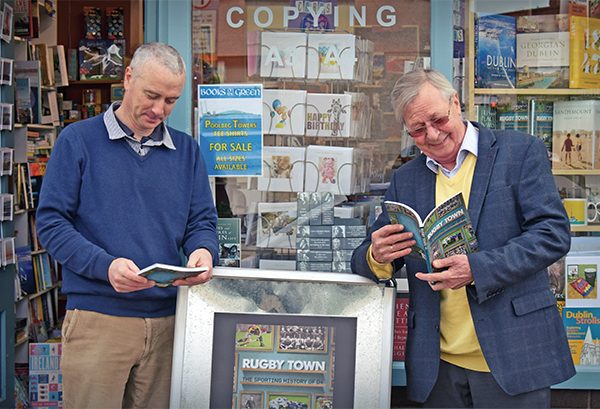
Pictured: Bookshop owner, Brian O’Brien, on left, and author Kurt Kullmann outside Books on the Green, Sandymount.
Photo: Kevin O’Gorman.
‘Rugbytown: The Sporting History of D4’, a recent book release by local history and sports enthusiast, Kurt Kullmann, was recently launched at Railway Union Clubhouse, Sandymount.
The book explains in great detail the history of the many sports clubs and organisations of D4, although, as noted in the book, it leaves out UCD as “most of it is in the county of Dún Laoghaire-Rathdown.”
The author was born in Bad Godesberg, Bonn, Germany during World War Two and eventually retired to Ireland with his Irish wife. Kullman has a deep interest in history and was a founding member of the Ballsbridge, Donnybrook and Sandymount Historical Society as well as being a volunteer guide in the Chester Beatty Library, giving tours about such things as biblical papyri (written in Greek).
In ‘Rugbytown’, Kullman states in his acknowledgements that it was “the Ballsbridge, Donnybrook and Sandymount Historical Society” which gave him “the idea of researching sport and its history in Dublin 4.”
The book describes a variety of sports, sports clubs and events other than just the sport of rugby. It also includes sports such as cricket, hockey, GAA, soccer and athletics. In the background to this sporting history, it notes many political, cultural, and sometimes religious connections to the growth of sport in Dublin 4. It is quite detailed and describes the establishment and history of a great many clubs in the area, though Kullmann was quick to say that there were things he was not able to cover in as much detail. Thankfully, there is humour and much passion in the narrative.
Formerly the Pembroke Township, Dublin 4 has quite a sporting legacy. Since the early habitation of the area by Irish tribes and later settlement by vikings, there are descriptions of sporting activities, familiar and unfamiliar, such as skating on a “bone skate” and playing hurling.
Much of the sports clubs and organisations that survive today grew out of the formalisation of sporting activities in the mid-19th century, when sports clubs and governing bodies, such as the Irish Rugby Football Union, were established and regular games and competitions could now take place. Many of the clubs survive today, though many more had disappeared or changed their name in these early years, as Kullmann observes.
Although the origins and enthusiasm with certain sports may have began earlier, such as horse racing or cricket, which are pre-19th century, the book predominantly deals with the 19th and 20th centuries.
Many of the sports mentioned take place in Sandymount. Indeed, the book has a clear focus on Sandymount. Kullmann explained that the focus was based on the great number of clubs there, the centrality of the area in relation to other clubs and facilities, as well as the fact that he was from the area himself.
The book frequently features Railway Union sports clubs, as there was an initial desire to form sporting clubs for the leisure of the railway workers employed in the area, many of whom came from Britain. This was significant as in the case of the hockey and cricket clubs and there were significant achievements from these clubs.
As the original rather Victorian statement reads: “To promote and encourage sport and games and other forms of social and athletic activities among the staffs [sic] of the railway and Steampacket Companies represented in Ireland.”
Recent successes for that club included a 2014 victory for the Railway Union ladies’ hockey team in the EuroHockey Club Trophy Championship. Railway Union cricketer, Niall O’Brien, played on the national team that beat the West Indies in the World Cup Pool B game in Nelson in February 2015.
Much of the development of sporting organisations in the area is due to the patronage of the Earl of Pembroke, who gave lands to early sporting organisations and helped establish certain clubs such as the grounds that would become Lansdowne Road stadium (now the Aviva stadium). This lease was granted to Henry W.D. Dunlop for the purpose of a multi-faceted sports ground. Interestingly, Lansdowne Road grounds are also home to two rugby clubs – Wanderers F.C. and Lansdowne – due to historical arrangements.
Dunlop is a particular figure who stands out in the book. He also founded Lansdowne Tennis Club, Lansdowne Archery Club, Lansdowne Cricket Club and Lansdowne Croquet club.
Signed copies of the book are available for purchase in Books on the Green in Sandymount for €15.99 with a mention of this paper (€17.99 excl.)
By Kevin Mac Sharry



